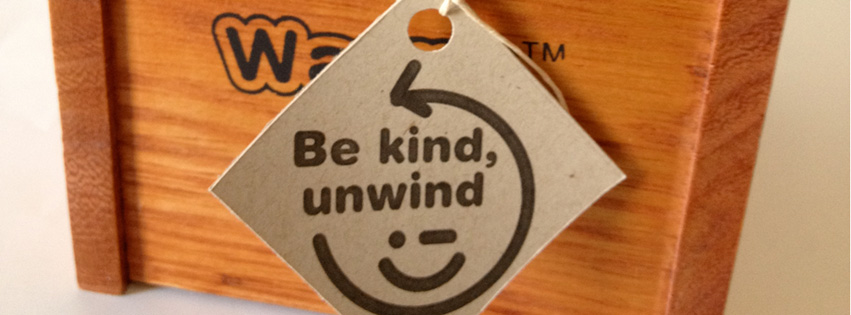
It was around two years ago that I shut down Warm Ventures, the startup I co-founded to pursue what I thought then might be a ripe opportunity in the gift marketing space. It failed, unfortunately, and this post aims to share some of my post-mortem thoughts on the experience – including some aspects that aren’t typical in more prominent startup stories.
Our main product originally was Warms, a platform that bridged the surprise and substance delivered by physical gift products with the emotion and versatility offered by digital videos and e-gifts. It consisted of a 4″x4″x4″ gift box with an elaborate unboxing experience revealing an audible heart-holding plush character and a unique code with instructions to view a video message (and, optionally, an e-gift) from the sender. “Cheaper than flowers and more substantial than e-cards, Warms have a sense of humor and are way more fun to give.” Here was the explainer video we made for them…
The physical item consisted of several custom pieces: a hinge-top wooden box with an interior elastic lever, a button-cell sound module (think audio greeting card), different versions of a small plush doll, a transparent under-lid label with a message and code (alphanumeric and QR), two brass tacks and a hemp string lid clasp with a “Be kind, please rewind” tag on the end, a card stock wrap to seal the box closed and tease to what’s inside, and all of this was mailed in a cubic cardboard box with a wax seal like sticker on top.
This is what one looked like…
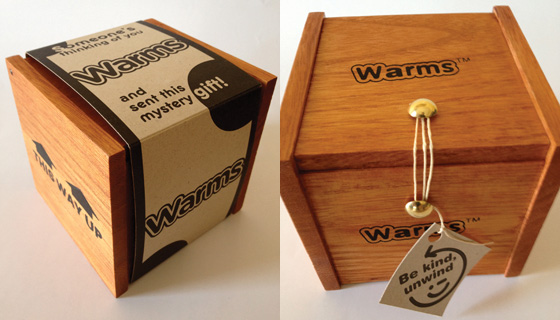
They looked great and by all accounts they were a pleasure for people to receive and open. Each unit was assembled by hand, something I’m glad we did. It was too early to outsource or automate assembly, and even though it could be a laborious process (particularly for Benny and I) the hands-on craftwork was actually one of the things that appealed to us about the project. It wasn’t just pixels.
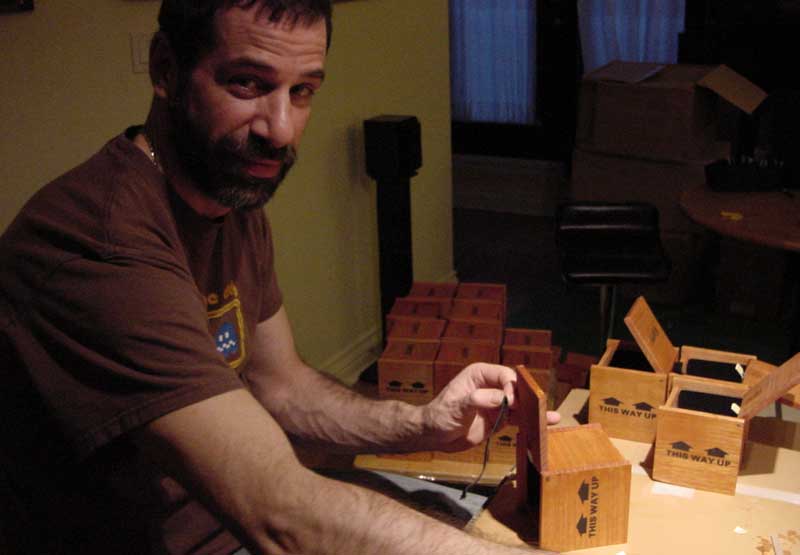
Benny working the gruelling assembly line.
The box itself was made out of real wood – paulownia (a regenerative root wood similar to bamboo) – based on our custom design and manufactured in China via a workshop sourced on Alibaba. There were a few key design decisions here that I think we got right: wood, custom, and overseas. We looked at cardboard or plastic box options but they all looked trashy for a gift item that we wanted to have some substance and longevity. We explored standard stock boxes but found ourselves in a huge gulf between high-end wine or jewellery cases and ugly fall-apart dollar store shells. And we explored box-makers closer to home but their prices were usually at least 4x as much, prohibitively expensive.
The doll too was custom-made. It perhaps didn’t need to be custom (at least in the early stages) but we felt that the figure was likely going to be our mascot – the face of the brand – so it needed to be something unique to us. Two of us had toy industry experience and connections (we worked with a US-based designer on the patterns and produced our first run with a Chinese manufacturer), so it wasn’t so intimidating for us to pursue this route. Ultimately, I think we missed the mark a bit with the doll’s look (too much like a nude baby than a Muppet-like creature) but production of the dolls was overall one of the smoother bits.
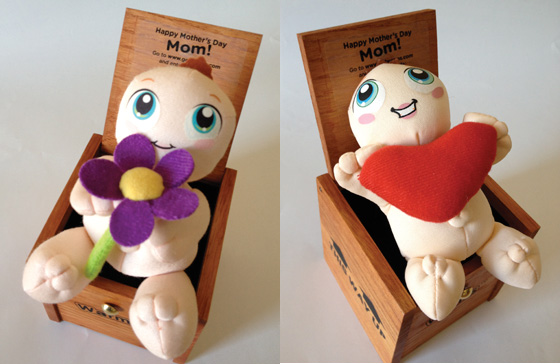
Likewise for the sound modules, which we sourced through a UK- and Hong Kong- based audio modules expert. We used an existing electronics unit affixed to cardstock custom specially trimmed and scored to tuck inside our wood boxes. It took some back and forth on samples – which, by the way, can be as expensive as the run itself – but got what we needed. I should mention that even having a sound card at all was a major decision for us because it added dollars to to the unit cost and all it said was “ta-dum!”. We almost left it out but I’m glad we didn’t; it delivered the essential giggle-inducing punctuation mark on the opening experience. The lesson here being that if you’re building an experiential product, you must go all-in on achieving an experiential moment.
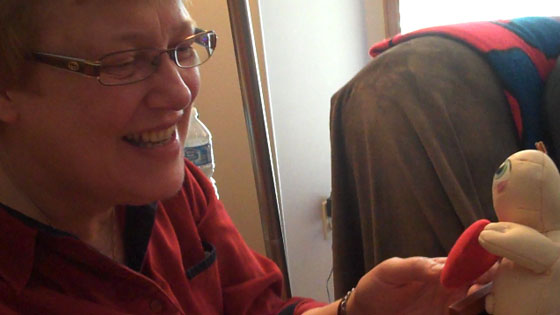
My mum opening a Warms for Christmas. She inspired the idea and I was so happy to deliver a smile while she was (successfully) battling cancer.
I’m sometimes asked about the experience working with Chinese factories – in our case three different types of factories (wood, fabric, electronics) – and my answer is that it was great. I started Warms while I was still working at a toy and consumer electronics company that had a sizable Kowloon office which in turn worked with several large factories (not the Alibaba-sourced ones we worked with). I saw then, and later with Warms, just how quickly the quality level – both for products and for customer service – was improving. The people I dealt with were smart, very eager to learn and adapt, and more proactive and responsive often than those I dealt with closer to home or in-person (for example, printing the simple cardstock wrap). There can be pitfalls, shady dealers, miscommunications, and of course the time difference (which you can use advantageously) but if you’re mindful of all that you should be fine.
Of course, one can’t talk about producing physical items without also addressing the movement of those goods. On the freight side of things, at least at the relatively small quantities (500) of our initial batch, the Canada customs documentation was generally straightforward (we were incorporated and had the necessary numbers) and we shipped via EMS (postal). I stored the cases in my basement locker, which was a short-term solution we never grew beyond.
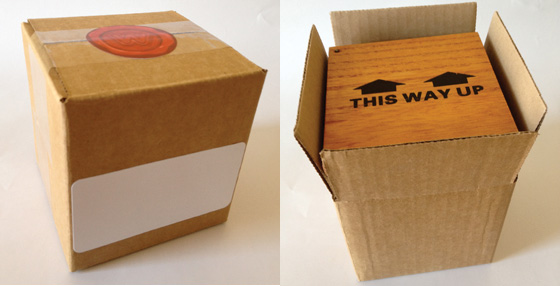
Fulfillment, on the other hand, was almost immediately unscalable as a manual process. We unfortunately never got to the point of having to handle a busy holiday surge, for example, but even the modest-sized mail-outs of reviews and early orders were time-consuming and would have needed extra attention. For one thing, we underestimated the challenges of day-specific greetings. We’d intended initially to go the casual “thinking of you” gift track and ship via regular parcel post. However, that doesn’t work so well for popular occasions like Valentines Day where the delivery window is hours, not days. The other thing we learned was how completely indifferent Canada Post and USPS were to working with a small startup. We naively figured that they’d welcome enterprises that, in the age of dwindling postmail, were actively championing the joy of getting actual postmail. Couldn’t have been more wrong on that assumption.

On the whole, however, the physical product was solid. It was still very much a work-in-progress but it was most definitely presentable as an MVP and sellable in pilot runs, which we did. But the physical aspect was only half of the Warms experience. The box and unboxing were just clever ways to deliver a custom URL/code that revealed a personalized video message and e-gift. This was the unique thing with Warms and where there was the most creative and revenue potential (eg. margin on gift codes, retail partners, premium production services, etc.). Unfortunately, the digital half – surprisingly – proved to be the more difficult part – not because video and gift codes are especially complex but because technical co-founders are. Let me explain.
Warms was actually one of the ideas I’d had when I began working at a toy company in 2008. It didn’t go anywhere internally partly because of its digital dimension (not a traditional toy) and because of the tanking economy. Still, I thought there was something worth exploring and it stayed with me as a nagging “try me” idea. I mentioned it to one of my ex-colleagues, Patrick Perreault, at lunch one day and he immediately saw it’s potential. I roped in a brilliant product designer (Benny Dongarra), a super-talented video editor (George Simeonidid), and a trusted web design studio (Plank) to join as partners, and we agreed to pursue it as a side-project to see where it might go. That happened only when we secured the missing piece of the team: a programmer. When Phil joined, we were off.
Except that soon after joining, and barely into any substantial development, Phil was headhunted by Amazon and, of course, took off to Seattle for that golden opportunity. We were happy for him but it was definitely a setback. Patrick and I then had to search for a fill-in CTO, which is never an optimal position to be in. You always want to have the technical co-founder onboard at the outset. It was even more challenging because, despite the team’s strong commitment to Warms, it was still an unpaid side-project. Most good developers have their pick of interesting paid projects.
Nevertheless we found a new CTO (at a founder dating event) after a few months. He set to work on building our platform – from scratch, however, because he preferred Python over Phil’s Java. The new guy was slow, though, and we discovered months into his tenure that he was dealing with some heavy personal issues. Finally, he had a breakdown and bowed out, again leaving us with a sparse codebase and yet another programmer search. Meanwhile, the physical product was nearly ready, our bootstrapped monthly expenses were eating into my savings, and the holidays – prime gift-giving season – were fast-approaching.
I considered outsourcing the work but balked at it because of the cost. I preferred having someone who was close to the team, who could lead the technical side of the project long-term, and who would initially work for sweat equity like the rest of us.
Outside investment would have helped, and we were invited to speak with some angels/VCs, but the conversations weren’t really serious – largely due to both our disinterest in the distraction of fundraising and their disinterest in part-time co-founders (perfectly understandable but just a little hypocritical considering that VCs demand 150% effort from the founders they invest in while they themselves spread their time and risk across many projects). We also applied for a few entrepreneurial grants – all distracting and time-leeching in their own way.
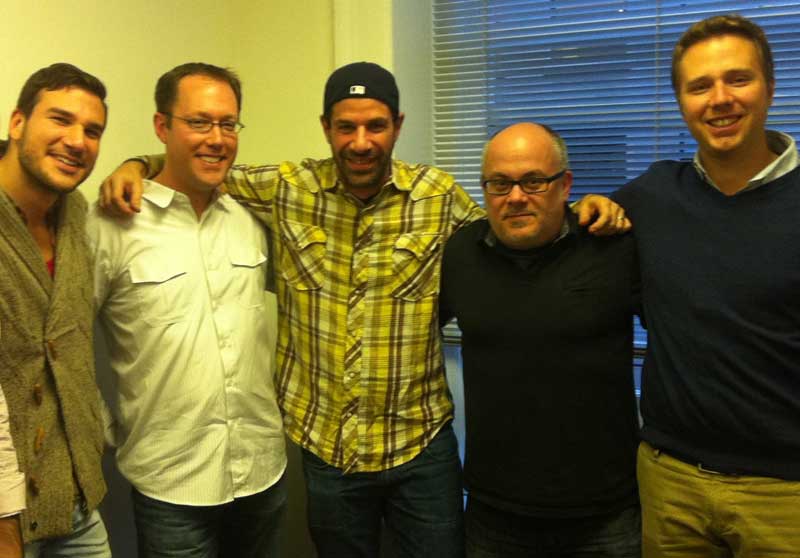
The team (l to r): George, me, Benny, Warren, and Patrick. A certain dev was cropped out.
We thought our luck shifted when, after a few more months of searching our networks, we landed an excellent developer, someone who’d just left a startup accelerator project. He would choose to code in Ruby (yet another language preference shift) and was aiming to have something ready for the holidays. Back on track after several months delay, I had our lawyers write him into our formal shareholders agreement, which had also been parked. Not more than a week after convening the team to sign the papers, the new developer called to back out. His wife had pressured him to get a real job. It was a real blow and his withdrawal at that critical point basically crippled the project.
We missed Christmas, but bounced back with a decent showing for Valentines Day, and we tried to recover using a Kickstarter for Mother’s Day. Problem was that even though Mother’s Day is a big gifting holiday, and some people try to give something more fun than flowers, few people plan ahead more than a couple days for it. Our Kickstarter flopped and it forced us to pivot the project into Whenabouts.
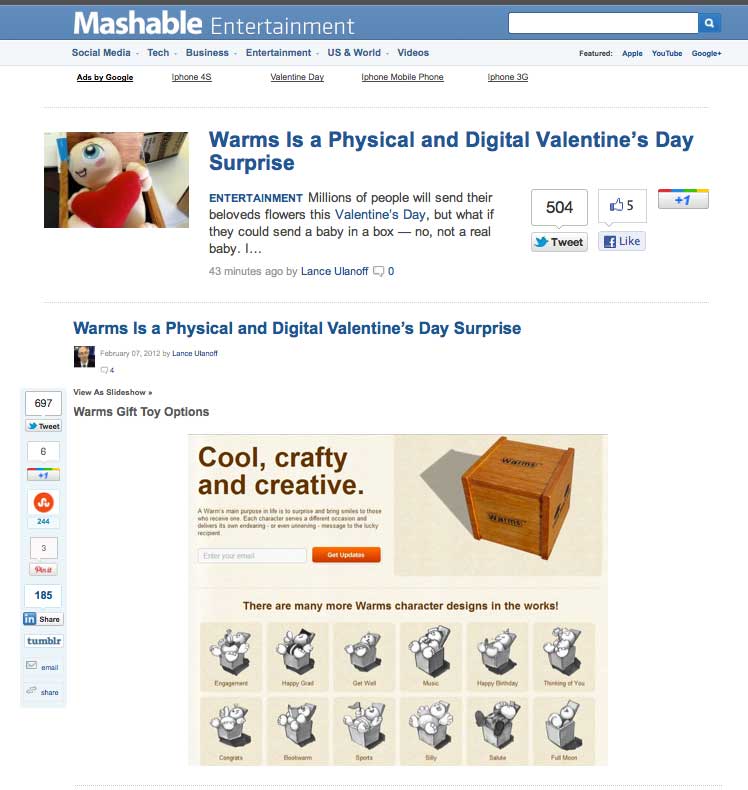
Our 15 minutes of fame on Mashable.
I can’t say if Warms would have been a rousing success if we’d had a consistent developer onboard from the beginning, but it certainly would have helped a lot. Without the multimedia platform, we were just a cute trinket – which wasn’t the market we were aiming for. In this category – filling the CTO seat – I think what Warms simply encountered bad luck; nothing that is especially teachable to other startups. That said, it tops a list of some other startup lessons for anyone still reading.
Lessons Learned
Shit happens. Keep moving. Or stop (not that any entrepreneur would though).
Don’t incorporate early. I chose to do so because I felt a formal shareholders agreement was an important signal to the team that what we were working on was real, even if it didn’t initially pay. But lawyers and accountants are expensive, and even though their advice was helpful their bills were not.
Do have a carve-out agreement. One agreement I’m glad I did formalize, if for no other reason than peace of mind, was a carve-out agreement with my former employer. Even though they had no interest in Warms, it was presented while on-the-job and could be considered their intellectual property under my employment agreement. I made sure they were aware of my side-project and that I owned the I.P.
Part-timing it is okay – for a while. Not all ideas warrant a full company launch or VC investment. I think the pressure put on inventors and entrepreneurs – particularly by investors – to jump from their day jobs straight into their startups is unnecessary. Warms first needed to be tested to see what potential it might have as an investable company. Much can be accomplished on evenings and weekends, and with a reliable pay cheque coming in. That said, there is a tipping point at which the new venture absolutely needs to become priority. We just didn’t reach it.
Sweat equity has a runway too. Runway is a startup’s working timeline before the dollars run out. In the case of a side-project like Warms where the co-founders had ownership but no income, patience is the capital that wears out. It’s still every bit as imperative to move as quickly as possible – and probably even more important because the “9 to 5” is applied elsewhere. Our developer delays gradually took the wind from our sails and stole focus from our goals.
Get more than sweat if you can. In hindsight, I would have asked my partners to chip in cash (for the modest hard costs, which I covered) in addition to their time – not so much for the money but for the commitment it would entail. Harder to back off or back out if you have skin in the game.
Use an intranet. Our team met weekly for dinner but our work was done from our home offices (and at odd hours). So virtual collaboration with a asynchronous updates and a shared file repository was essential. We used Cubetree (until SAP squashed it).
If you’re building an experiential product, go all-in on achieving an experiential moment.
Don’t be afraid of physical objects. Working with real tangible items can be fulfilling in a way that pushing pixels just isn’t. The work that goes into physical production is different and potentially dangerous but it can also be worthwhile.
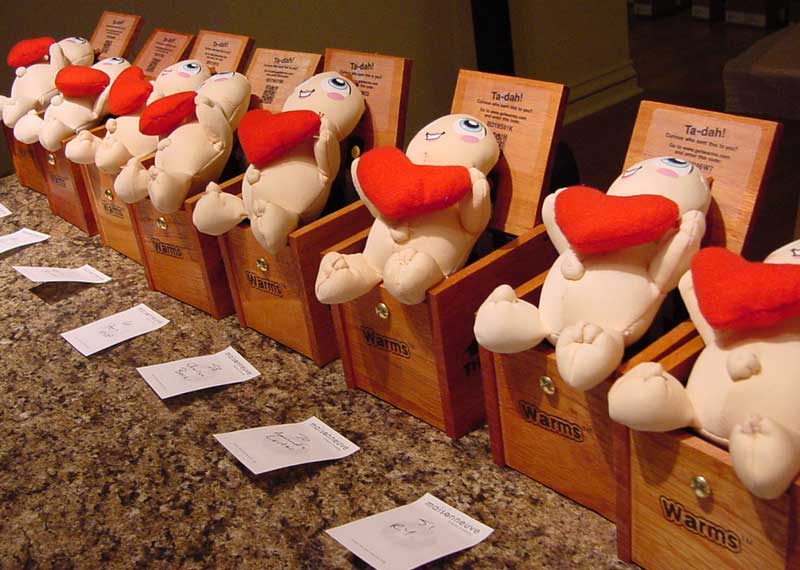
An army of hearts, preparing for deployment.
Although Warms was a failure as a business, it was a great journey as a project and as a learning experience. Now if anyone would like to buy some surplus boxes and dolls, just let me know!




